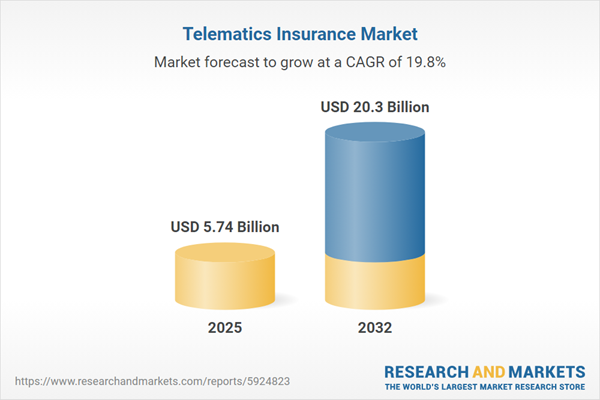Speak directly to the analyst to clarify any post sales queries you may have.
The telematics insurance market is transforming traditional risk assessment by leveraging real-time driving data and integrated analytics, creating new pathways for insurers to enhance operational performance and customer engagement. As technical innovation reshapes how risk and usage are measured, decision-makers must adapt to gain and retain business advantage.
Market Snapshot: Telematics Insurance Market Size and Growth
The telematics insurance market grew from USD 4.77 billion in 2024 to USD 5.74 billion in 2025. Sustained expansion is expected, with the sector projected to achieve a CAGR of 19.82%, reaching USD 20.30 billion by 2032. Growth is driven by increased adoption of data-driven solutions, regulatory support, and evolving expectations for transparent premium models. Heightened demand from commercial fleets, government programs, and individuals signals broadening applicability across segments and geographies.
Scope & Segmentation of the Telematics Insurance Market
This report delivers comprehensive insight and forecasts across core sub-segments, providing actionable intelligence for insurers, technology vendors, and mobility partners seeking to capitalize on telematics insurance opportunities.
- End User: Corporate fleet operators, delivery services, rental agencies, emergency services, public transport fleets, peer-to-peer car sharers, private vehicle owners, shared mobility users.
- Telematics Model: Manage How You Drive (coaching, feedback, risk management), Pay As You Drive (distance or time-based), Pay How You Drive (behavior and journey-based analytics).
- Vehicle Type: Heavy commercial vehicles, light commercial vehicles, passenger cars, road motorcycles, and scooters.
- Technology: Embedded OEM systems, OBD-II plug-in devices, smartphone-based apps for Android and iOS, wearable telematics bands and watches.
- Distribution Channel: Broker networks, direct insurers, automotive OEM-led initiatives.
- Deployment Mode: Cloud-based (public or private), hosted third-party solutions, and in-house platforms.
- Geography: North America (United States, Canada, Mexico), Latin America (Brazil, Argentina, Chile, Colombia, Peru), Europe (United Kingdom, Germany, France, Russia, Italy, Spain, Netherlands, Sweden, Poland, Switzerland), Middle East (UAE, Saudi Arabia, Qatar, Turkey, Israel), Africa (South Africa, Nigeria, Egypt, Kenya), Asia-Pacific (China, India, Japan, Australia, South Korea, Indonesia, Thailand, Malaysia, Singapore, Taiwan).
- Key Players: The Progressive Corporation, Allstate Corporation, State Farm Mutual Automobile Insurance, AXA S.A., Allianz SE, Assicurazioni Generali, Admiral Group, MAPFRE, Zurich Insurance Group, Tokio Marine Holdings.
Key Takeaways for Senior Decision-Makers
- Real-time analytics and AI-driven telematics are enabling insurers to shift from reactive risk assessment to predictive, behavior-based underwriting and claims handling.
- Regulatory support for usage-based insurance models and transparent pricing frameworks accelerates adoption, while stringent data privacy standards address consumer concerns.
- Collaborations among automotive manufacturers, telematics providers, and insurance carriers drive integrated ecosystems and facilitate rapid solution deployment.
- Customization of telematics programs, including flexible deployment models and hardware-agnostic architectures, allows carriers to serve both commercial fleets and personal users efficiently.
- Regional differences in regulatory environments, infrastructure maturity, and consumer digital adoption require localized go-to-market strategies to capture growth opportunities.
- Emerging technologies such as blockchain enhance data integrity and streamline claims processes, improving operational efficiency and reducing fraud risk.
Tariff Impact: Navigating U.S. Trade Policy Changes
Recent tariffs introduced in the United States have amplified hardware procurement costs for telematics devices and connectivity modules, impacting program economics for carriers. Insurers and solution providers are adapting through strategies like nearshoring production, leveraging domestic chip supply, and accelerating software-driven architectures. These moves help offset cost pressures, maintain product modularity, and sustain innovation, while downstream pricing adjustments and premium incentives ensure continued consumer engagement.
Methodology & Data Sources
A robust mixed-methods approach underpins this research, blending primary interviews with executives across insurance, hardware, OEM, and regulatory sectors with extensive secondary data synthesis. Quantitative analysis and statistical modeling validate key trends and segment dynamics, ensuring accuracy and actionable recommendations for all stakeholders.
Why This Report Matters
- Equips leaders with clarity on technology advancements, segment viability, and evolving business models in telematics insurance.
- Enables informed decision-making by providing detailed competitive profiling, regional adoption patterns, and regulatory implications.
Conclusion
The telematics insurance market is advancing on the strength of data-driven, collaborative strategies that reward innovation and adaptability. Organizations that leverage emerging technologies and navigate evolving regulations are best positioned for sustainable growth and enhanced value creation.
Additional Product Information:
- Purchase of this report includes 1 year online access with quarterly updates.
- This report can be updated on request. Please contact our Customer Experience team using the Ask a Question widget on our website.
Table of Contents
3. Executive Summary
4. Market Overview
7. Cumulative Impact of Artificial Intelligence 2025
Companies Mentioned
The companies profiled in this Telematics Insurance market report include:- The Progressive Corporation
- Allstate Corporation
- State Farm Mutual Automobile Insurance Company
- AXA S.A.
- Allianz SE
- Assicurazioni Generali S.p.A.
- Admiral Group plc
- MAPFRE S.A.
- Zurich Insurance Group AG
- Tokio Marine Holdings, Inc.
Table Information
| Report Attribute | Details |
|---|---|
| No. of Pages | 184 |
| Published | October 2025 |
| Forecast Period | 2025 - 2032 |
| Estimated Market Value ( USD | $ 5.74 Billion |
| Forecasted Market Value ( USD | $ 20.3 Billion |
| Compound Annual Growth Rate | 19.8% |
| Regions Covered | Global |
| No. of Companies Mentioned | 11 |









